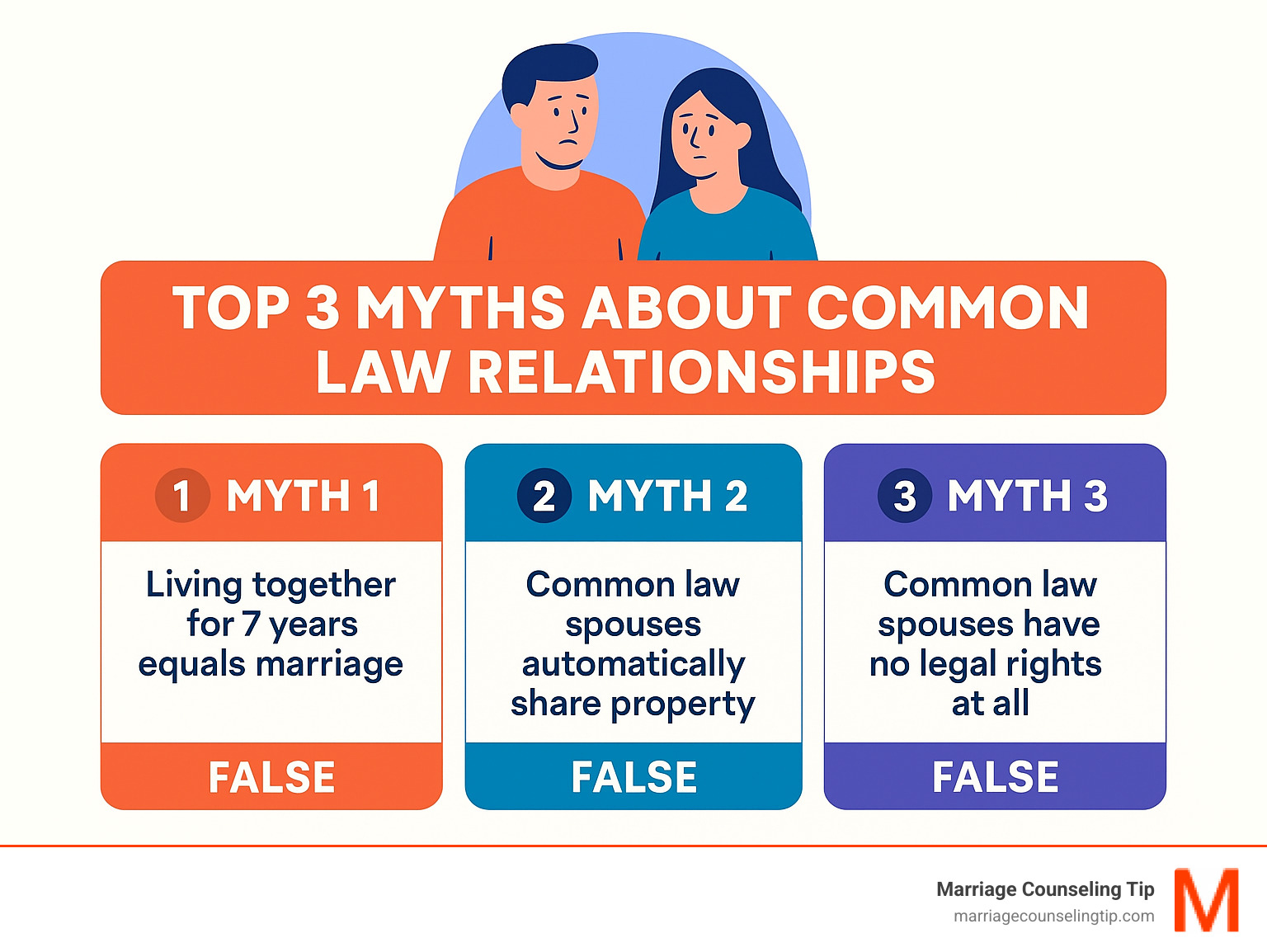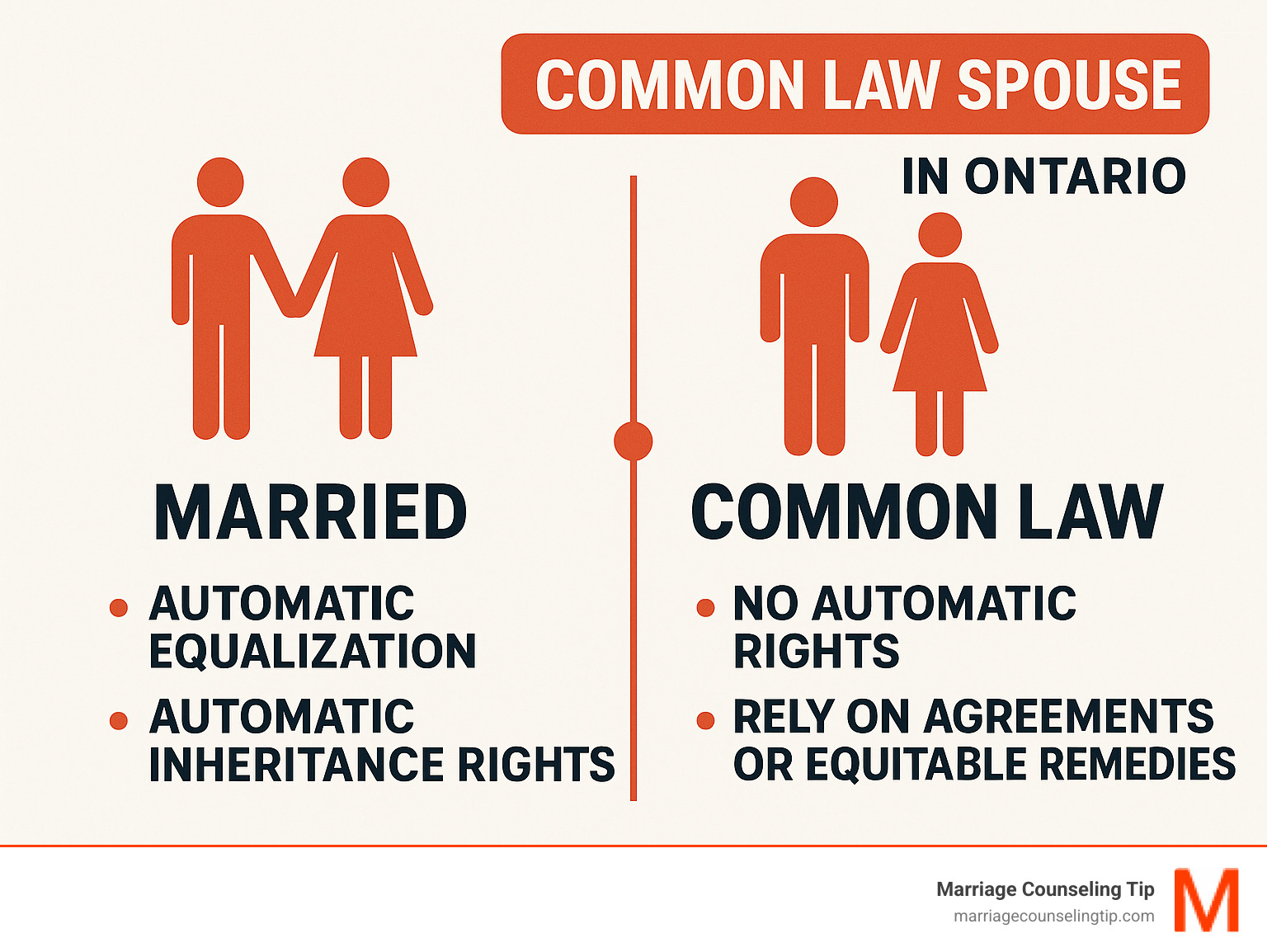
Why Understanding Common Law Spouse Rights Matters for Your Relationship
When you hear common law spouse, you might think it means the same thing as being married – but that’s one of the biggest misconceptions couples face today.
Quick Answer: What is a Common Law Spouse?
- In Ontario: Two people living together for 3+ years OR 1+ year with a child
- Key Difference: Common law spouses have limited legal rights compared to married couples
- Property Rights: No automatic right to share property (unlike marriage)
- Support Rights: Can claim spousal support after separation
- Inheritance: No automatic inheritance without a will
The reality is much more complex than most people realize. As one family law expert put it: “It is surprising to many that common-law couples have no automatic claims to assets or property.”
This confusion isn’t just about legal technicalities – it can devastate relationships when couples find their assumptions about their rights were wrong. Many couples assume that living together for years automatically gives them the same protections as marriage. Others believe the opposite – that they have no rights at all.
These misunderstandings create unnecessary stress, arguments about money, and fear about the future. When you don’t know where you stand legally, it’s hard to feel secure in your relationship or make important decisions together.
Understanding your actual legal status helps you protect both your relationship and your future. Whether you’re planning to stay common law or considering marriage, knowing the facts lets you make informed choices about your life together.

What is a Common Law Spouse in Ontario?
If you’ve been living with your partner for a while, you might wonder if you’re considered a common law spouse in Ontario. The answer isn’t as straightforward as you might think, and it’s definitely not what most people assume.
Here’s the thing that surprises many couples: there’s actually no such thing as a “common law marriage” in Ontario. You’re either legally married or you’re not. What does exist is something called a “common law partnership” or “unmarried spouse” status – and it comes with some rights, but not nearly as many as marriage.

Think of it this way: if marriage is like having a full membership to a club with all the benefits, being a common law spouse is more like having a day pass. You get some access, but not to everything.
The Family Law Act in Ontario defines who counts as a spouse in two different ways – one for married couples and another for common law partners. But here’s where it gets tricky: different laws use different definitions. What makes you a common law partner for tax purposes might be different from what makes you one for family law purposes.
Defining a Legal Marriage
Let’s start with the clear-cut option: legal marriage. When you get married, you have a formal ceremony, get a marriage license, and register with the government. It’s official, it’s documented, and there’s no guessing about your status.
Marriage creates a legal union that’s recognized everywhere in Canada. If things don’t work out, the federal Divorce Act kicks in with clear rules about how to divide property, handle support, and deal with children.
It’s like having a roadmap when you need it most. Both provincial and federal laws work together to protect married spouses, and everyone knows exactly where they stand.
Criteria for a Common Law Relationship
Now, becoming a common law spouse in Ontario is quite different. There’s no ceremony, no paperwork to sign, and no exact moment when it “happens.” Instead, it’s all about how you’ve been living your life together.
The main way to become common law partners is by living together for 3 years in what the law calls a “conjugal relationship.” This isn’t just about sharing an apartment – it means living like a married couple would. You’re sharing your lives, your finances, your daily routines, and presenting yourselves to the world as a couple.
But here’s an important shortcut: if you’re living together with a child (whether born to you or adopted), you only need to live together for one year to be considered common law partners. The law recognizes that having children together creates a different level of commitment and permanence.
What makes a relationship of some permanence? It’s about more than just time. You’re likely sharing finances, maybe you’ve bought furniture together, you attend family events as a couple, and your friends think of you as a unit. You support each other emotionally and financially, and you’ve built a life together that looks a lot like marriage from the outside.
The tricky part is that shared finances and home arrangements can vary a lot between couples. Some keep everything separate, others combine everything. Some own property together, others don’t. This is why proving common law status can sometimes be complicated if it’s ever questioned.
One thing that’s really important to understand: the definition of a common law spouse changes depending on which law you’re dealing with. For tax purposes, the Canada Revenue Agency says you’re common law after just 12 months of living together. But for family law in Ontario, it’s usually three years (or one year with a child).
This might seem confusing, but it makes sense when you think about it. Different laws are trying to protect different things – tax laws want to prevent people from claiming benefits they shouldn’t, while family laws are more focused on long-term relationships that need protection when they end.
Property & Finances: The Biggest Legal Divide
Here’s where things get really complicated, and honestly, where many common law spouse relationships face their biggest shock. You might think that living together for years feels just like marriage, but when it comes to your money and property, the law sees things very differently. This is probably the most important distinction between married and common-law relationships in Ontario – and it’s the one that catches couples off guard the most.

Picture this: You’ve been together for eight years, bought a house together, shared all your expenses, and built what feels like a solid financial partnership. Then the relationship ends. If you’re married, Ontario law steps in with clear rules about splitting everything fairly. But if you’re a common law spouse? Well, that’s where things get messy.
The truth is, married couples get automatic protection when their relationship ends. The law says “let’s divide this fairly.” But for common-law couples, there’s no such safety net. You generally keep what’s in your name, period. It doesn’t matter how much you contributed or how unfair it seems.
Property Division for Married Spouses
When married couples separate in Ontario, the system is pretty straightforward. It’s called equalization of net family property, and it’s designed to be fair. Here’s how it works: each spouse adds up what they owned when they got married, then what they own at separation. The difference shows how much wealth they built together during the marriage.
The spouse who accumulated more wealth during the marriage pays the other an equalization payment. This ensures that the financial gains from their years together get split 50/50. It’s automatic – no arguing about who deserves what.
The matrimonial home gets special treatment too. Even if only one spouse’s name is on the deed, both have equal rights to live there. This protects the spouse who might have focused on raising kids or supporting the family in other ways while their partner’s name went on the paperwork.
Both spouses must provide financial disclosure – basically showing all their cards so everything’s transparent. Often couples work out a separation agreement to make the division official without going to court.
Property Claims for a Common Law Spouse
Now here’s the hard truth for common law spouses: there’s no automatic equalization. No 50/50 split. No special protection for the family home. You keep what’s legally yours, and that’s it.
This reality hits couples hard. We’ve seen people who spent years paying into a mortgage, renovating a home, or supporting a partner’s business, only to walk away with nothing because their name wasn’t on the right documents.
But don’t lose hope completely. The law does offer some ways to fight back, though they’re much more complicated and expensive. These are called equitable remedies, and they’re designed to prevent truly unfair outcomes.
Unjust enrichment is the main tool available. You need to prove three things: your partner got richer, you got poorer because of your contributions, and there’s no good legal reason why they should keep all the benefits. For example, if you paid for major home renovations while your partner paid down their mortgage, you might have a case.
Constructive trust is another option. This is when a court decides you should own part of something, even though your name isn’t on the title. It often goes hand-in-hand with unjust enrichment claims. The court might say “yes, the house is in their name, but you should own 30% of it because of what you contributed.”
Resulting trust typically comes up when you paid for something but put it in your partner’s name. Maybe you gave them money for a down payment, or transferred your inheritance to help buy the family home. The law assumes they’re holding it in trust for you, unless they can prove you meant it as a gift. The Supreme Court of Canada dealt with these complex situations in cases like Kerr v Baranow.
The catch? Proving contributions can be incredibly difficult, especially non-financial ones. How do you put a dollar value on years of managing the household so your partner could focus on their career? These cases are emotionally draining and expensive, which is why prevention is so much better than trying to fix things after a breakup.
Inheritance Rights for a Common Law Spouse
This is where the difference between married and common law spouse status can be absolutely devastating. When a married person dies without a will, their spouse automatically inherits a significant portion of the estate under Ontario’s intestacy laws. It’s built-in protection.
But if you’re a common law spouse and your partner dies without a will? You might get nothing. Zero. It doesn’t matter if you lived together for twenty years or raised children together. The law simply doesn’t recognize you as an heir.
This harsh reality makes estate planning absolutely critical for common-law couples. You need a will that specifically names your partner as a beneficiary. You also need to carefully check beneficiary designations on RRSPs, TFSAs, and life insurance policies.
Here’s a scary scenario we’ve seen: someone lists their “spouse” as the beneficiary on their life insurance, thinking it means their common-law partner. But they’re still legally married to someone else, even though they’ve been separated for years. Guess who gets the money? The legal spouse, not the person they actually shared their life with.
The importance of a will cannot be overstated for common law spouses. Without one, your partner could be left financially devastated at the worst possible time. It’s one of those things that seems like it can wait – until it can’t.
Support, Children, and Domestic Contracts
Here’s where things start to level out a bit. While property division creates a huge gap between married couples and common law spouses, the playing field becomes much more equal when it comes to support obligations and children’s rights. This shift happens because the law focuses on protecting vulnerable family members – whether that’s a financially disadvantaged partner or children who need care.

Think of it this way: the law might not care if you had a wedding ceremony when it comes to dividing up your house, but it absolutely cares about making sure children are supported and that no one is left destitute after a relationship ends.
At Marriage Counseling Tip, we see how these legal realities affect families every day. Understanding your rights and options can reduce anxiety and help you focus on what really matters – healing and moving forward together as a family, even if your romantic relationship has ended.
Spousal Support Rights and Obligations
Here’s some genuinely good news for common law spouses: when it comes to spousal support, you’re on much more equal footing with married couples. The law recognizes that financial dependencies and sacrifices happen in all long-term relationships, not just ones that started with a wedding.
If you’ve been living together for three years or more, or for one year with a child together, you can claim spousal support after separation. The court looks at whether one partner gave up career opportunities, stayed home with children, or otherwise became financially disadvantaged because of the relationship.
The key factors include your economic disadvantage from the relationship, the needs and means of each partner, how long you were together, and your ability to become self-sufficient. For example, if you put your partner through medical school while working two jobs, or if you stayed home for years caring for children, the court recognizes these contributions deserve financial protection.
The duration of support varies widely. A shorter relationship might result in support for just long enough to get back on your feet, while a decades-long partnership could mean longer-term or even indefinite support, especially if you’re older or have health issues that limit your earning capacity.
Determining Custody and Child Support
When children are involved, your marital status becomes completely irrelevant. The law has one overriding concern: the best interests of the child. Whether you’re married, common law, or never lived together at all, your obligations and rights as parents are identical.
The Children’s Law Reform Act guides all decisions about parenting time (what used to be called custody) and decision-making responsibility for major choices about your child’s life. Courts consider factors like each parent’s ability to provide stability, the child’s relationship with each parent, and the child’s own preferences if they’re old enough to express them.
Child support follows the federal Child Support Guidelines regardless of your relationship status. These are standardized tables based on the paying parent’s income and number of children. If you earn $60,000 per year and have two children, you’ll pay the same amount whether you were married to your ex or lived common law.
Both parents have a legal duty to support their children financially. This isn’t negotiable or something you can sign away in an agreement. The child’s right to support belongs to the child, not the parents.
Cohabitation Agreements vs. Marriage Contracts
Given everything we’ve discussed about property rights, you might be wondering: “Can common law spouses create some of the protections that married couples get automatically?” The answer is absolutely yes, through something called domestic contracts.
These agreements are like creating your own personalized rule book for your relationship. Instead of leaving everything up to the sometimes harsh default rules of the law, you and your partner decide together how you want to handle finances, property, and support.
Cohabitation agreements are designed specifically for couples living together without marriage. They can outline property division upon separation, set support terms in advance, and clarify financial responsibilities during the relationship. For common law spouses who don’t have automatic property rights, these agreements can be incredibly powerful protection tools.
Marriage contracts (often called prenups) serve a similar purpose for married couples, allowing them to override the standard equalization rules and create their own system for asset division.
Both types of contracts require independent legal advice for each partner. This means you each need your own lawyer to explain the agreement and ensure you understand what you’re signing. It might seem like overkill, but it protects both of you and makes the agreement much more likely to hold up in court.
We encourage couples to think of these agreements not as planning for failure, but as mature financial planning. Just like you wouldn’t start a business without a partnership agreement, creating legal certainty about your relationship can actually reduce stress and conflict. When everyone knows the rules ahead of time, there’s less room for nasty surprises later.
Frequently Asked Questions about Common Law Relationships
When it comes to common law spouse relationships, we get asked the same questions over and over again. It’s clear there’s a lot of confusion swirling around out there – and honestly, who can blame people? The rules aren’t exactly straightforward, and there’s so much misinformation floating around that it’s hard to know what’s true.
Let’s clear up some of the biggest misconceptions we hear in our counseling practice.
What if one partner is still legally married to someone else?
Here’s a situation that might sound like a soap opera plot, but it’s actually more common than you’d think. Yes, you absolutely can have a common law spouse while still being legally married to someone else.
This happens when someone separates from their legal spouse but never gets around to filing for divorce. Maybe it’s too expensive, too complicated, or they just keep putting it off. Then life moves on, they meet someone new, and before they know it, they’re in a committed relationship that meets all the criteria for common-law status in Ontario.
But here’s where things get messy. This creates two sets of spousal obligations – and trust us, that’s as complicated as it sounds.
Your matrimonial home rights belong to the married spouse, not your new common-law partner. So even if you’ve been living with your new partner for years, your legal spouse still has rights to that original family home. Meanwhile, support obligations can exist for both partners. You might find yourself owing spousal support to your legal spouse while also potentially owing support to your common-law partner if that relationship ends too.
And don’t even get us started on inheritance issues. Without proper estate planning, your assets could end up going to your legal spouse instead of your common law spouse – even if you haven’t spoken to your legal spouse in years.
It’s like trying to juggle while riding a unicycle. Possible? Sure. Recommended? Not really.
Is a “common-law marriage” a real thing in Canada?
This is the million-dollar question, and the answer might surprise you. “Common-law marriage” is a myth – at least in the legal sense that most people think about it.
Here’s the thing: it’s a social term, not a legal one. People use it all the time, but legally speaking, there’s no such thing as a “common-law marriage” in Canada. You’re either legally married (with all the rights and responsibilities that come with it) or you are a “common-law partner” with specific, limited rights. There’s no magical moment where living together suddenly transforms into marriage.
The term causes significant confusion about legal status, and we see this confusion cause real problems for couples. They assume that after seven years (or some other random number they heard somewhere), they’ll automatically have all the same rights as married couples. Then they’re shocked to find that’s not how it works at all.
Think of it this way: calling yourself a “common-law marriage” is like calling your bicycle a motorcycle. You can call it whatever you want, but it’s still not going to give you the same ride.
Do my common law rights transfer between provinces?
Unfortunately, no, family law is provincial, which means your common law spouse rights don’t pack up and move with you when you relocate.
The definition of a common-law spouse and the rights they have can vary significantly from one province to another. It’s like each province has its own recipe for what makes a common-law relationship, and some of those recipes are pretty different.
What applies in Ontario may not apply in British Columbia or Quebec. In Ontario, you generally need three years of living together (or one year with a child) to be considered a common law spouse for support purposes, and there’s no automatic property sharing. But hop over to another province, and the rules might be completely different.
Quebec is particularly unique with its civil law system. Common-law partners there (called “de facto spouses”) have very limited property rights unless they’ve signed a cohabitation agreement. It’s almost like moving to a different country in terms of your legal rights.
This is why we always tell couples: if you’re moving provinces, don’t assume anything about your legal status. Get local legal advice to understand how your rights might have changed. It could save you a lot of heartache down the road.
Conclusion: Protecting Your Relationship and Your Future
After reading through all these legal complexities, you might be feeling a bit overwhelmed – and that’s completely normal! Understanding what it means to be a common law spouse in Ontario isn’t just about memorizing legal definitions. It’s about protecting the life you’re building together and making sure you both feel secure about your future.
The reality is that many couples find these legal differences at the worst possible time – during a breakup or after losing a partner. We’ve seen too many people learn the hard way that their assumptions about their rights were wrong. The emotional impact of legal stress during an already difficult time can be devastating.

But here’s the good news: proactive planning can prevent most of these problems. Think of it like getting insurance for your relationship – you hope you’ll never need it, but you’ll be grateful it’s there if you do.
Communication is absolutely key here. These aren’t easy conversations to have with your partner, but they’re necessary ones. Talk openly about your expectations, your financial contributions, and what you both want for your future. Many couples find that having these discussions actually brings them closer together because they’re being honest about their hopes and concerns.
If you’re a common law spouse, creating wills and cohabitation agreements isn’t optional – it’s essential. A will ensures your partner inherits what you want them to have. A cohabitation agreement lets you decide how you want to handle finances and property, rather than leaving it up to complex legal battles later.
Don’t forget about beneficiary designations on your RRSPs, life insurance, and other accounts. These simple updates can save your partner enormous headaches during an already difficult time.
The truth is, being a common law spouse can be just as fulfilling and committed as being married. The difference is that you need to be more intentional about protecting yourselves legally. It’s like the difference between having a safety net automatically installed versus having to build your own – both can work, but one requires more effort upfront.
If these legal complexities are creating tension in your relationship, or if you’re feeling stressed about where you stand, support is available. Sometimes couples need help navigating these conversations and decisions together. Learn how our counseling services can help you build a stronger partnership – we understand that legal uncertainty can put strain on even the strongest relationships, and we’re here to help you work through it together.
Your relationship deserves protection, and you deserve peace of mind. Taking these steps now means you can focus on what really matters – building a happy, healthy life together.





